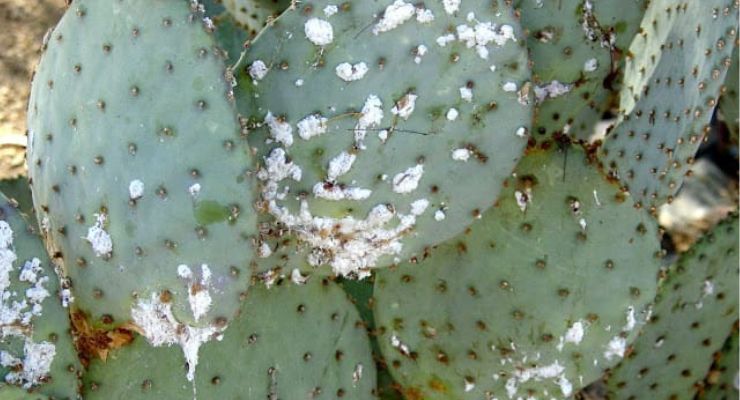Cactus plants are known for their unique appearance and ability to thrive in harsh environments. However, like any other plant, cacti can develop health issues that can affect their growth and appearance.
One common issue that cactus growers may encounter is the development of white spots on the plant’s surface. These spots can appear on any part of the cactus, including the stem, leaves, and flowers, and may be indicative of various underlying causes.
In this article, we will explore the possible reasons for the development of white spots on outdoor or indoor cacti plants and provide tips on how to identify and treat them.
White Spots Characteristics
It can have different characteristics depending on the cause of the issue. Some common characteristics of white spots on cactus plants include:
Size and shape: The size and shape of the white spots can vary depending on the type of cactus and the cause of the spots. They can range from tiny pinpricks to larger, raised bumps or patches.
Texture: The texture of the white spots can also vary. They may be smooth, rough, or slightly fuzzy to the touch.
Color: While the spots are typically white or yellowish, they can also be brown or black in some cases.
Location: The white spots can appear on any part of the cactus, including the stem, leaves, and flowers.
Cause: White spots can be caused by a range of factors, including pests, fungal or bacterial infections, sunburn, and physical damage.
If you notice white spots on your cactus, it’s important to identify the cause of the issue and take appropriate action to address it. Some common treatments for white spots in cacti include removing infected areas, applying fungicides or insecticides, and adjusting the cactus’s environment to prevent further damage.
Causes of White Spots on Cactus Plants
Environmental factors causing white spots on cactus
Sunburn
Sunburn on cacti plants can occur when they are exposed to direct sunlight for extended periods without adequate protection. This can happen both indoors and outdoors, as cacti require plenty of sunlight to grow but can also be susceptible to damage from intense or prolonged exposure.
When a cactus is sunburned, it can develop white or brown spots on its surface, which can be unsightly and affect the overall health of the plant. These spots are a result of the sun’s intense UV rays causing damage to the cactus’s cells.
To prevent sunburn on cacti, it is essential to provide adequate protection from direct sunlight. One effective way to do this is to move the cactus to a location with partial shade from the direct sun. This could be a place like under a shaded tree or an area of the garden.
Another option is to use a shade cloth, which can be draped over the cactus to provide protection while still allowing adequate sunlight to reach the plant.
It is also important to be mindful of the amount of sunlight a cactus is receiving and to gradually increase the amount of sun exposure over time. This can help the cactus to acclimate to higher levels of sunlight and reduce the risk of sunburn.
Mineral deposits
Mineral deposits are a common cause of white spots on cacti. Hard water or excessive use of fertilizers can cause minerals to accumulate on the surface of the cactus, resulting in unsightly, white patches or spots. This can be particularly problematic in areas with high mineral content in the water or soil.
To prevent mineral deposits from forming on your cactus, it is important to use the right type of water when watering your plant. Distilled water or rainwater are good options, as they are free of minerals that can accumulate on the cactus. If you don’t have access to these types of water, you can also use tap water that has been treated with a water softener or a water filtration system.
In addition to using the right type of water, it is also important to avoid over-fertilizing your cactus. Excessive use of fertilizers can cause minerals to accumulate in the soil, which can then be absorbed by the cactus and result in white spots. To prevent this, use a balanced, slow-release fertilizer and follow the instructions carefully to avoid over-fertilizing your plant.
If mineral deposits do appear on your cactus, they can be removed by gently wiping the affected areas with a soft, damp cloth. Be careful not to scrub too hard or use any harsh chemicals, as this can damage the cactus.
Human factors causing white spots on cactus
Overwatering
Overwatering, a common cause of root rot, can also cause white spots on cactus as it can lead to fungal or bacterial infections that appear as white spots. It’s important to let the potting soil dry out between waterings and ensure the pot has proper drainage to avoid overwatering.
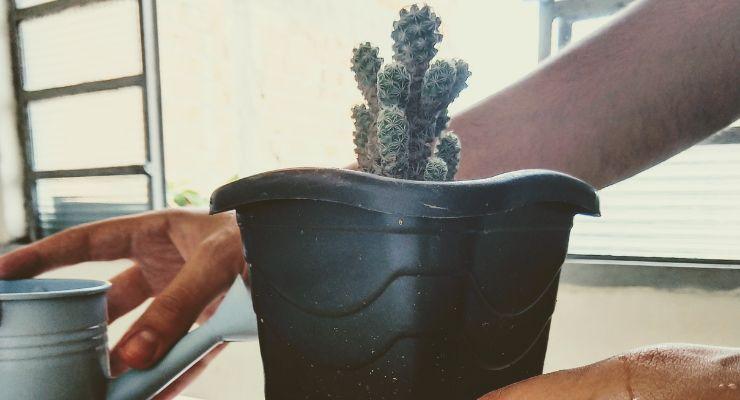
Using tap water
Using tap water to water cactus can cause white spots due to the accumulation of minerals in the soil. Minerals such as calcium and magnesium can form white spots on the cactus. It’s best to use distilled or rainwater for watering cactus.
Fertilizer burn
Over-fertilizing can cause white spots on cactus as it can lead to salt buildup in the soil, which can appear as white spots on the plant. It’s important to follow the recommended dosage of fertilizer for cactus.
Handling
Handling cacti can be tricky as they have spines that can cause injury or irritation. Additionally, touching the cactus with bare hands can cause white spots on the plant. The natural oils and sweat from human skin can transfer to the cactus, leading to discoloration.
To avoid causing white spots while handling cacti, it’s best to wear gloves. Choose gloves that fit well and provide adequate protection against the spines. Leather gloves or gardening gloves are good options for handling cacti.
When handling the cactus, use a pair of tongs or a cloth to hold it instead of grabbing it with your hands. This will help you avoid getting pricked by the cactus spines, and reduce the chances of causing white spots.
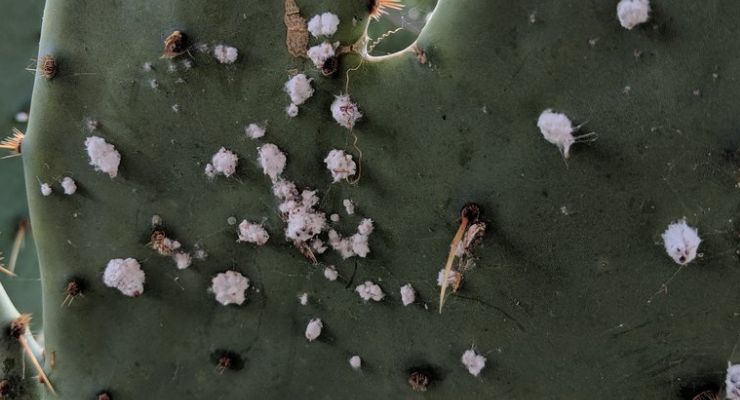
Pests and diseases causing white spots on cactus
Fungal or bacterial infections are a common cause of white or brown spots on cacti. These infections can be caused by a variety of fungal or bacterial pathogens, and can occur when the cactus is exposed to excess moisture, high humidity levels, or poor ventilation.
Overwatering is a common cause of fungal or bacterial infections in cacti. When the soil is kept too wet, it creates the perfect environment for fungi and bacteria to thrive, leading to the development of white or brown spots on the cactus. It is essential to ensure that the soil is well-draining and that the cactus is not watered too frequently.
High humidity levels can also contribute to fungal or bacterial infections in cacti. When the air is too humid, it can create a damp environment that is conducive to fungal and bacterial growth. It is important to ensure that the cactus is kept in an area with good air circulation and low humidity levels.
To prevent fungal or bacterial infections in cacti, it is essential to provide proper care and maintenance. This includes avoiding overwatering, ensuring proper ventilation and air circulation, and maintaining a healthy growing environment.
Additionally, it is important to keep an eye out for any signs of infection, such as white or brown spots on the cactus, and to take appropriate measures to address the issue promptly.
Mealybugs
Mealybugs are a common pest that can affect succulent plants. These tiny white insects feed on the sap of the cactus, causing damage to the plant and leaving behind unsightly white spots or cottony masses.
Mealybugs are typically found on the stems, leaves, and flower buds of various cacti species. They are often introduced to cacti plants through contaminated soil or from other infested plants. Mealybugs can be challenging to control, as they reproduce quickly and can rapidly infest an entire cactus if left unchecked, causing stunted growth.
To control mealybugs on cacti, it is essential to identify the mealybug infestation very early and take appropriate measures to address the issue. One effective method of control is to wipe the affected areas with a cotton swab dipped in rubbing alcohol. This can help to kill the mealybugs and remove any visible white spots or cottony masses.
It is also important to take steps to prevent future pest infestation, such as inspecting new plants before introducing them to your collection and providing proper care and maintenance for your cacti. This includes avoiding overwatering, providing adequate ventilation and air circulation, and using a well-draining soil mix.
In severe cases, it may be necessary to use chemical treatments to control mealybugs on cacti. However, it is important to follow the instructions carefully and use these treatments as a last resort, as they can be harmful to the cactus and the environment.
Scale insects
Scale insects are common pests that can infest cacti, causing white spots on the plant. These insects secrete a waxy coating that looks like white spots and can be found on the stems, leaves, and flowers of the cactus. Scale insects can be challenging to control, as they often attach themselves firmly to the cactus and reproduce quickly.
One effective way to control scale insects on cacti is to apply insecticidal soap or neem oil to the affected areas.
These products work by suffocating the insects and breaking down their protective waxy coating, making them more susceptible to control. It is important to follow the instructions carefully when using these products, as they can be harmful to the cactus if not used properly.
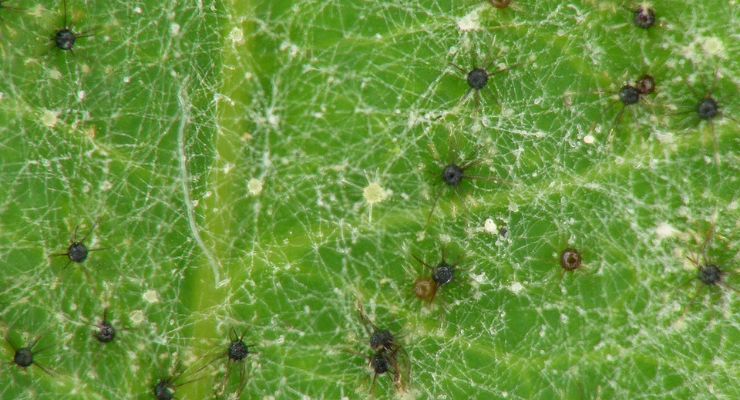
Powdery mildew
Powdery mildew is another fungal disease that can cause white spots on cacti. This disease thrives in humid conditions and can be prevented by ensuring good air circulation and avoiding overwatering.
If powdery mildew does appear on your cactus, it can be treated with fungicides. However, it is important to identify and address the underlying cause of the problem, such as poor ventilation or overwatering, to prevent future outbreaks.
Bacterial soft rot
Bacterial soft rot is a bacterial disease that can cause white spots on cacti. It usually affects the lower parts of the plant and can be identified by soft, mushy spots that turn white. Bacterial soft rot can be prevented by avoiding overwatering and ensuring good drainage.
If you suspect that your cactus has bacterial soft rot, it is important to act quickly and remove any affected areas to prevent the disease from spreading to other parts of the plant.
Prevention and Treatment of White Spots on Cactus
White spots on cactus can be prevented through proper cultural practices, the use of chemical and organic treatments, and other preventative measures.
To prevent white spots caused by overwatering, ensure that the soil is dry before watering the cactus again. Cacti require a well-draining soil mixture to prevent excess water retention.
To prevent sunburn, move the cactus to a location with partial shade or use a shade cloth to protect it from direct sunlight.
Additionally, avoid using tap water to water the cactus as it contains minerals that can accumulate in the soil and cause white spots. Instead, use distilled or rainwater.
Chemical and organic treatments can also be used to control other pests and diseases that cause white spots on cactus. Insecticides can be used to control pests such as mealybugs and scale insects, while fungicides can be used to control fungal diseases such as powdery mildew. Organic treatments, such as neem oil, can also be used to control pests and diseases. Use a spray bottle to apply a solution on the affected area.
Proper cultural practices, such as ensuring proper ventilation and using a well-draining soil mixture, can also prevent the buildup of humidity that can cause fungal and bacterial infections. Additionally, proper plant spacing can prevent overcrowding, which can lead to poor air circulation and the buildup of humidity.
By following these preventative measures and implementing proper treatment as necessary, white spots on cactus can be prevented and treated effectively.
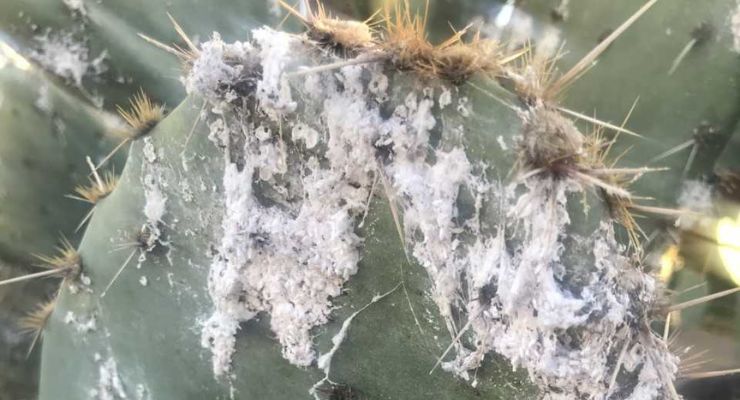
FAQ
Can white spots on cactus be harmful to human health?
White spots on cactus are generally not harmful to human health, and there is no evidence to suggest that they can cause any adverse health effects.
Are cactus white spots contagious to other plants?
White spots on cactus are typically not contagious to other plants, as they are caused by specific pests or diseases that target infected cacti only. However, it is still important to isolate an infected cactus to prevent the spread of the pest or disease to other nearby plants.
Can I save a cactus with severe white spot infestation?
Whether a cactus with severe white spot infestation can be saved depends on the extent of the damage and the underlying cause of the white spots.
If the white spots are caused by a fungal or bacterial infection, the affected parts of the cactus may need to be pruned off, and a fungicide or bactericide applied to prevent further spread.
If the white spots on infected plant are caused by pest infestation, insecticides may be necessary to control the pests. In some cases, a severely infested cactus may not be able to be saved, and it may be necessary to dispose of it to prevent the spread of the pest or disease to other plants.
Conclusion
Cacti are fascinating and unique plants that can bring a touch of the desert into any home or garden. As with any plant, it is essential to provide proper care to ensure their health and vitality. This includes providing the right amount of water, sunlight, and nutrients, as well as preventing pest and disease infestations.
White spots on cacti can be a sign of various issues, including pest infestation, fungal or bacterial infections, or sunburn. By identifying the underlying cause of the white spots and implementing the appropriate preventative and treatment measures, cactus owners can maintain the health and beauty of their plants.
In conclusion, proper care is crucial to the overall health and well-being of any indoor or outdoor cacti, and it is important to be vigilant for any signs of issues, such as white spots. With the right care and attention, cacti can thrive and bring joy to their owners for many years to come.
